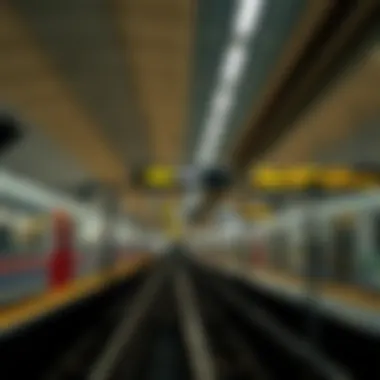Understanding Dubai Metro Ticket Pricing and Options


Intro
Navigating the urban expanse of Dubai can be a true adventure, especially when you consider the many options at your disposal. While once upon a time, the car ruled the road, the advent of the Dubai Metro has reshaped the transport narrative, offering a modern, efficient alternative that many have quickly come to love. Understanding the nuances of Metro pricing isn’t just for the daily commuter or the occasional tourist; it's a golden opportunity for investors, property buyers, and anyone who wishes to grasp the financial fabric of this dazzling city.
As we plunge into the world of Dubai Metro prices, we will dissect ticket types, fare structures, and how these elements play into the broader scope of travel expenses in this bustling metropolis.
Market Trends and Insights
Current Trends in Dubai Real Estate
The real estate market in Dubai has witnessed waves of transformation in recent years. With the Expo 2020 showcasing the city's evolving skyline, there is an undeniable buzz that permeates through residential and commercial properties alike. High-rise buildings and luxury apartments spring up akin to desert flowers after the rain, attracting investment from both local and international buyers.
Moreover, the strategic positioning of various properties in proximity to the Metro stations has become a focal point. Areas such as Downtown Dubai, Dubai Marina, and Jumeirah have become prime spots where property hunters seek value, combining convenience with luxury living.
"Proximity to the Metro not only enhances the appeal of a property but often translates into increased real estate values over time."
Predictions for Future Market Developments
As Dubai continues to evolve and expand, experts predict a steady surge in not just real estate prices, but also in Metro utilization. With new lines and expansions on the horizon, ticket pricing will inevitably adjust to these changes.
Investors looking to capitalize should keep an eye on the forthcoming developments and the potential administrative adjustments to the fare structure. Buying properties that grant easy access to the Metro can be a sound strategy. It’s prudent to keep your ear to the ground regarding housing trends and pricing shifts, as the market has shown it can be both unpredictable and rewarding.
Luxury Developments and Properties
Spotlight on Iconic Developments
Dubai isn't just about skyscrapers; it’s a profound blend of architectural innovation and luxury living. Iconic developments such as Burj Khalifa, Palm Jumeirah, and Dubai Creek Tower highlight the city’s commitment to grandeur. These areas not only symbolize the city's luxury but are also strategically located close to transit points like the Metro, making them highly desirable for affluent buyers.
Investing in Luxury Properties: A Guide
Investing in luxury properties demands thorough research. Here’s a simplified route to navigating this complex market:
- Understand the Neighborhood: Getting to know areas around Metro stops can make or break your investment. Look for amenities, schools, and shopping districts.
- Know the Demand: Luxury living options near metro stations often have higher demand, particularly from expats.
- Check Future Developments: Analyze city planning reports to see if new stations will be built, giving your property future value.
A well-placed sound investment in Dubai is often a ticket to success, both for the owner and the Dubai Metro system that serves it.
For more detailed information, check Wikipedia or the Dubai Government for official insights.
Intro to Dubai Metro
The Dubai Metro represents a remarkable engineering achievement and a vital component of the city's infrastructure. As a public transportation system, it not only alleviates traffic congestion but also stands as a testament to the UAE's commitment to sustainable urban development. The metro network plays a pivotal role in facilitating the movement of residents and visitors across the bustling landscape of Dubai, linking major commercial and residential neighborhoods, tourist attractions, and key business districts.
In the context of this article, understanding the pricing structure of the Dubai Metro is crucial for several reasons. First, it provides insight into how the system operates financially, impacting both individual commuters and the broader economy. Second, the variety of fare options available can significantly influence daily commuting costs, making it essential for potential residents, investors, and visitors alike to grasp these aspects.
Moreover, with Dubai's rapid growth and its positioning as a global city, the metro's pricing structure directly affects property values and investment opportunities in proximity to stations. For example, areas close to metro stations often see property demand skyrocket due to ease of access. Understanding this relationship can benefit real estate investors and homebuyers, as the metro becomes a selling point in the competitive property market of Dubai.
As we delve deeper into the nuances of the Dubai Metro's pricing and ticketing, this article aims to equip readers with comprehensive knowledge that helps navigate the financial landscape of urban travel in one of the world's most dynamic cities.
Overview and Significance of the Metro System
The Dubai Metro is not merely a transportation alternative; it symbolizes the ambitious vision of the UAE to transform its economy while addressing the challenges of urban mobility. Launched in 2009, the metro has quickly evolved into one of the most efficient and advanced transit systems globally, featuring both automated and driver-operated trains.
One significant aspect of the metro system is its integration with other forms of public transport, such as buses and water taxis. This seamless connectivity encourages the use of public transport, thereby reducing the reliance on personal vehicles—an essential move towards sustaining an eco-friendly urban environment.


Furthermore, the expansion of the metro network continues to reflect the city’s growth. New lines and stations are gradually being introduced, increasing coverage and making it easier for people to rely on public transport. As cities worldwide grapple with the complexities of urban pollution and congestion, Dubai sets an example of how a well-planned metro system can enhance the quality of urban living.
Key Features of Dubai Metro
The Dubai Metro boasts a myriad of features that contribute to its effectiveness and popularity among commuters. Some of the key elements include:
- Driverless Trains: One of the standout features is the fully automated train operation, ensuring a safe and efficient transit experience.
- Modern Stations: Designed with contemporary architecture, the metro stations are equipped with cutting-edge facilities, such as free Wi-Fi, elevators, and accessibility options for persons with disabilities.
- Real-Time Updates: Commuters benefit from real-time information displays that provide updates on train schedules and service status, enhancing convenience.
- Safety Standards: The metro adheres to stringent safety regulations, utilizing advanced technology for surveillance and emergency response systems.
This blend of features positions the Dubai Metro as not just a mode of transportation but also as a lifestyle choice for many. With its increasing significance in urban planning, understanding the operational and pricing mechanisms becomes imperative for anyone looking to grasp the dynamics of Dubai's public transport system.
Current Price Structure
Understanding the current price structure of Dubai Metro is essential for both residents and visitors. It not only defines how much one expects to pay to use the system but also helps in making informed decisions, especially for daily commuters and tourists. Knowing the fare categories, ticket types, and available discounts can ultimately save costs and ensure an efficient travel experience through the city.
Standard Fare Categories
The fare system operates primarily on a distance-based model. Think of it as a pay-as-you-go structure, where the price of your trip adjusts based on how far you travel. Here's how the fare works:
- Zone Structure: Dubai Metro divides the city into several zones. For instance, an individual traveling within one zone may incur a minimal fare compared to someone traveling across two or more zones. This setup provides flexibility and a sense of fairness as commuters only pay for the distance they cover.
- Price Points: The standard fares for a single journey range from AED 3 to AED 8.5, depending on the number of zones crossed. Each zone's fare is tiered, which promotes efficient travel without breaking the bank.
This transparent fare system encourages residents and tourists alike to make the most of the public transport without worrying about exorbitant prices.
Types of Tickets Available
Single Journey Tickets
Single journey tickets are as straightforward as they come. These tickets simplify the travel process for those who need to hop on and off without needing a long-term commitment. Priced between AED 3 and AED 8.5, this option covers journeys across one to three zones. One of the key characteristics that make single journey tickets appealing is that they're useful for casual travelers—those visiting a tourist attraction or attending business meetings.
- Unique Feature: The one-off nature of these tickets allows flexibility, as users can purchase them as needed. However, the drawback is such tickets cannot be reused, often making them less cost-effective for regular travelers, particularly in a bustling city like Dubai.
Day Passes
Day passes open the door to unlimited travel within Dubai Metro for a full day. This type is ideal for tourists, or anyone exploring the city at leisure. For around AED 20, individuals gain access to the whole network for a 24-hour period.
- Key Characteristic: The ability to travel freely encourages exploration without the worry of accumulating ticket costs. Moreover, the fare covers all zones which makes hopping on and off a breeze.
However, while the day pass promotes unlimited access, it is important to consider that it may not be the most economical choice for those only needing a few trips during the day.
Monthly Passes
For those who rely heavily on the metro for daily commuting, monthly passes can be a game changer. Priced at AED 300 for adults and AED 150 for students, these passes allow unlimited rides for an entire month.
- Key Characteristic: The monthly pass significantly reduces per-trip costs, especially for frequent commuters. As one can imagine, a worker who uses the metro daily would quickly find value in this option compared to purchasing individual or even daily tickets.
The flip side is that it requires a commitment, which may not suit occasional travelers. That said, for residents, the ease of walking to the station and hopping on a train without worrying about payment each trip is revolutionary.
Children, Students and Senior Citizen Discounts
Discounts for children, students, and senior citizens constitute an important aspect of Dubai Metro's pricing structure. Children under the age of five travel for free, ensuring that families can navigate the public transport system without the added burden of ticket costs for young ones.
Students can also benefit from reduced fares, which helps in promoting public transport usage among the youth. Likewise, senior citizens enjoy discounts, acknowledging their contribution to the community and making transport more accessible.
Overall, these considerations not only help in fostering a community spirit but also cater to the city's emphasis on inclusivity. By making the metro system affordable for varied demographics, Dubai ensures that the public transport system remains a viable option for all.i
Additional Costs


When navigating the financial landscape of Dubai, the cost of transportation plays a significant role, especially regarding the Metro system. This segment sheds light on the additional costs associated with using the Dubai Metro beyond the standard ticket fares. These additional costs not only provide insight into commuters' overall expenses but also highlight essential elements that can impact choices for residents and visitors alike.
Understanding the full spectrum of costs, such as the acquisition fee for the NOL Card and the reloading and usage charges, is crucial. These charges can affect the affordability of commuting and can influence decisions made by potential investors or those considering relocating. Furthermore, clear comprehension of these expenses may lead to better budgeting strategies and financial planning for individuals relying on the Metro system for daily transport.
NOL Card Acquisition Fees
To access the Dubai Metro, one must first obtain a NOL Card, which is essential for all rides. This card isn’t simply a means of entry; it represents a seamless integration of payment across various modes of transport in the city. The acquisition fee typically sits at AED 25. This fee covers the initial cost of the card itself, which includes a non-refundable charge of AED 20 and a remaining balance of AED 5 that can be used for subsequent travels.
Some commuters might skimp on understanding this upfront fee, but neglecting this point could lead to budget overruns or unexpected expenses later on. For frequent users, it’s advisable to think of the NOL card as a long-term investment rather than a mere startup cost. Here's a quick look at the NOL Card options:
- Silver Card: Ideal for occasional users. It allows for easy reload and usage.
- Gold Card: For those who prefer the luxuries of the metro and wish to enjoy exclusive benefits.
- Blue Card: This variant is specially designed for students and requires proof of eligibility for discounts.
This initial investment can substantially streamline the commuting experience while also enabling riders to budget more effectively for travel throughout the bustling city.
Reloading and Usage Charges
There’s more to consider when evaluating the financial implications of using the Metro, particularly regarding reloading the NOL Card and the corresponding usage charges. After purchasing the initial card, users must ensure it stays topped up to avoid any travel interruptions. The fees associated with reloading the card depend on the amount chosen and the location of the transaction.
Generally, it is recommended to reload between AED 20 and AED 100 at various locations, including metro stations and authorized retailers. Additionally, there is a small service fee that may apply, which is usually minimal but worth considering.
"Understanding these reload and usage charges can significantly impact the overall commuting expenses for daily travelers."
Moreover, it’s vital for users to be mindful of the suburban travel limitations of their Metro card type. For example, special fares apply for trips extending into certain zones, thereby necessitating a careful examination of travel routes to avoid surprises at the gates. Keeping a close eye on how often the card is reloaded and strategizing route choices can help in wrangling down the overall commuting costs.
Comparison with Alternative Transportation
In evaluating the overall landscape of public transport in a bustling metropolis like Dubai, understanding the price dynamics of the Metro compared to other modes of transport is vital. When navigating from point A to point B, one must often weigh cost, convenience, and time in their decision-making process. This section aims to shed light on how the Dubai Metro fares against other transportation options such as taxis, ride-sharing services, and buses.
Cost Analysis of Taxis and Ride-Sharing Services
Taxis operate as a convenient choice for many residents and tourists who value speed and direct routes. However, this luxury comes at a price. A typical taxi ride in Dubai can vary widely based on distance, traffic conditions, and time of day, reflecting fares that can quickly pile up. To illustrate:
- Base Fare: The starting rate for taxis is approximately AED 12 during daytime, increasing slightly at night.
- Per Kilometer Charge: Expect to pay around AED 1.96 for each subsequent kilometer.
- Airport and Booking Fees: Hailing a cab from the airport incurs an additional charge of AED 20, not to mention potential surge pricing during peak times when using ride-sharing apps like Uber and Careem.
While taxis can be a lifesaver for anonymous trips, especially late at night, such convenience could lead to a more robust dent in your wallet compared to the Metro.
Moreover, ride-sharing services, while often marketed as a cost-effective alternative, can also lead to unexpected spikes in fare due to surge pricing during rush hours or events. Therefore, when cost is a critical concern, using the Metro could be the more economical choice for everyday commutes.
Buses vs Metro: A Financial Perspective
Dubai's bus system is extensive, serving myriad routes throughout the city, which makes it an affordable alternative to the Metro. However, several factors play into deciding between these two transit options.
- Fare Comparison: A bus ticket costs between AED 3 to AED 8, depending on the distance. Conversely, a Metro ticket ranges from AED 3 for a single journey with a standard fare to AED 8 for longer trips, still representing a slight edge in cost-effectiveness for the latter.
- Time Factor: Trains run frequently, with intervals ranging from 2 to 10 minutes during peak times, shrinking waiting periods considerably. Buses, on the other hand, may not operate as efficiently during off-peak times. The wait time for buses can often double, especially in less populated areas.
- Route Efficiency: If your destination is one of the many high-traffic stops on the Metro's Silk Route, the time saved can be significant. However, for locations off the beaten path, buses may offer routes that provide necessary access where Metro lines do not.
Key Takeaways
The balance between cost and convenience is crucial in choosing transport in Dubai. While payouts for taxis or ride-sharing can add up, the Metro stands out for both affordability and time efficiency on popular routes.
In summary, the financial implications of choosing between the Metro and alternative transport options highlight not just their operational efficiencies but also reveal the growing demand for affordable commute solutions in Dubai's evolving urban landscape.
Implications of Pricing on Residents
Understanding the implications of Dubai Metro pricing is vital for residents, particularly when examining the financial landscape of living in this vibrant city. As the metro system contributes to the urban fabric of Dubai, pricing structures can significantly influence day-to-day life, transportation accessibility, and even long-term financial decisions, especially for potential homebuyers and investors.


Affordability and Economic Impact
The affordability of Metro fares can shape how residents budget for their monthly expenses. For many commuters, reliance on the metro means the difference between comfortable living and financial strain. Prices of the tickets must align with the income levels of typical residents, making it crucial for the metro authority to keep fares reasonable. A balance between affordability and adequate service quality can lead to a more satisfied population.
Moreover, as the cost of living rises, small changes in fare rates can bear substantial impact. If the metro fares increase, it may force many to reconsider their transportation preferences or even their residential choices. This can lead individuals to seek housing options closer to their workplaces or areas with better access to less-costly public transport alternatives. These shifts can have a ripple effect on the economy as a whole.
- Residents looking for budget options may favor areas with lower rents but farther distances from metro stations.
- Those in high-density zones might see increases in demand for properties, driving up property rental prices due to their proximity to transportation hubs.
Another major facet to consider is the potential increase in congestion. If metro fares become less affordable, it may push more residents to rely on personal vehicles or taxis, leading to traffic build-up and environmental degradation. Economic implications may extend beyond finances, affecting overall community well-being as commuting becomes less pleasurable.
Influence on Property Values in Proximity to Metro Stations
The presence of metro stations often has a significant impact on property values in their vicinity. Real estate experts frequently note that homes located near metro stations typically garner higher prices, primarily because of the convenience offered to residents committing to daily commutes. Proximity to efficient public transport can make a neighborhood more desirable, attracting both long-time residents and investors looking to enter the property market.
- New developments around metro stations can see rates shoot up tremendously in a short period.
- A neighborhood’s reputation can dramatically improve simply based on its access to the metro system, pushing existing residents' home values higher and enticing new buyers.
It is worth noting, however, that the inverse can also occur. Should metro pricing become prohibitive, or if service quality declines, property values may stagnate or decline as demand wanes. Investors and homeowners should stay attuned to any shifts in metro fare structures, as these changes are not just monetary but can influence the vibrancy and growth of entire neighborhoods.
“The value of convenience in transportation cannot be overstated. The affordability of metro fares can truly make or break a neighborhood’s appeal.”
Future Developments in Metro Pricing
In the landscape of modern urban transport systems, the fare structure of a metro network plays a pivotal role in shaping its accessibility and popularity among residents and visitors. The focus on future developments in metro pricing in Dubai is not only important but essential for understanding how this dynamic city aims to address the challenges of urban mobility while catering to a diverse user base. With the continuous growth in population and tourism, adapting the pricing mechanisms can significantly impact commuter choices, financial planning for city authorities, and even long-term real estate trends.
Projected Amendments to Fare Structure
As Dubai Metro gears up for its next phase of evolution, potential amendments to the fare structure are on the horizon. These adjustments are largely motivated by the desire to remain competitive not just with local transport options, but also with global metro systems that offer a blend of cost-effectiveness and convenience.
One consideration may include a tiered pricing structure based on distance traveled. For instance, passengers could find themselves paying a flat fee for short trips, while longer journeys could see incremental fares. This change serves several purposes—it prevents short-haul users from covering extensive fees and encourages longer journeys, which ultimately streamlines congestion and enhances utility.
Moreover, there’s been chatter about introducing promotional pricing during off-peak hours. For example, evening or midday trips might come at a discount to utilize the full capacity of the metro. The motivation there is plain: enhance ridership and maximize operational efficiency. Investors in the real estate sector should note such developments, as increased usage typically leads to higher property values near stations.
Innovations and Sustainability in Transportation
The connection between innovations in metro systems and their sustainability practices cannot be overstated. As global focus sharpens on eco-friendly development, Dubai Metro is looking to be at the forefront of this shift by integrating sustainable growth strategies.
Innovative practices could come in the shape of green fare structures. Imagine a scenario where commuters are offered discounted fares for choosing non-peaking hours or utilizing eco-friendlier commute choices, like bringing bicycles or walking part of the way to the station. This not only encourages sustainable transit habits but potentially decreases the residents' transportation costs.
Furthermore, investing in renewable energy sources for powering the metro is another exciting development in the pipeline. Solar panels on station rooftops or using wind turbines nearby can significantly lower operational costs, translating to possibly lower fares in the future.
"Transportation pricing strategies heavily influence commuters’ choices. The metro's sustainability and fare structuring decisions could shape Dubai's economic landscape for years to come."
Stay tuned while Dubai is crafting a potentially unrivaled metro experience, both for users and stakeholders alike.
End
The analysis of Dubai Metro prices reveals a pivotal aspect of urban mobility that significantly impacts both residents and visitors. It's not just about getting from point A to point B; it reflects deeper economic dynamics within a rapidly growing metropolis. As we look closer at the fare structures, myriad ticket options, and hidden costs, we begin to see how well the metro aligns with the broader goals of sustainability and economic accessibility.
Overall Analysis of Metro Prices and Their Impact
Dubai Metro's pricing structure offers a glimpse into how a city can cater to a broad audience. The standard fare categories ensure that both frequent commuters and occasional riders can find a suitable price point to meet their needs. This flexibility is particularly welcoming for expats and tourists who wish to navigate the city without breaking the bank.
The NOL card, as discussed in earlier sections, complements this pricing scheme. It provides convenience and encourages the use of public transport—an essential factor for environmental considerations. The overall affordability of metro tickets can potentially lower the financial burden on daily commuters, thus impacting their spending and lifestyle positively. As property investors and buyers look towards the future, understanding the implications of metro accessibility on real estate values should not be overlooked.
In neighborhoods near metro stops, one can typically observe an uptick in property values. This connection reinforces the idea that efficient transportation systems directly correlate with economic growth.
Final Thoughts on Navigating Dubai's Transportation Costs
In summation, navigating through the transportation costs in Dubai, especially when it comes to the metro, requires a discerning eye and a strategic mindset. The variety of ticketing options allows riders to tailor their transport expenses based on personal circumstances, making it increasingly easier to budget for mobility.
Moreover, as Dubai continues to grow, so too will the innovations within its transportation systems. Future amendments to pricing structures coupled with enhancements in service can help sustain the city's development while still being accommodating to those who rely on public transport. Real estate investors, homebuyers, and even expats must keep themselves informed on these changes, as they could present opportunities or challenges in the ever-evolving market.















